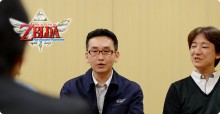Iwata Asks – Lanayru Desert
Posted on November 07 2011 by Locke
 The fourth installment of the Iwata Asks: Skyward Sword series is up, and this time, following the pattern, they’re talking about Lanayru Desert. The developers responsible for this region describe the inspiration for it, and much of its gameplay and puzzles. Hop inside for a bullet-point summary and video. Obviously, there are spoilers.
The fourth installment of the Iwata Asks: Skyward Sword series is up, and this time, following the pattern, they’re talking about Lanayru Desert. The developers responsible for this region describe the inspiration for it, and much of its gameplay and puzzles. Hop inside for a bullet-point summary and video. Obviously, there are spoilers.
- There are three distinct areas in Lanayru Desert – each transforms into something new. This is unique to the desert, the other two regions modeled after returning several times and playing the same area over again.
- The second area of the desert becomes a sea. You travel around by boat, and the dungeon here is a large ship drifting on this sea. (This is the second dungeon of Lanayru Desert, in which you fight Scervo and Tentalus.)
- The transformation between past and present continues the Zelda series’ tradition of contrast. Ocarina of Time was especially an influence. This time, they wanted to be able to travel anywhere, not just by going to one location.
- This is home to the ancient civilization mentioned in the first interview, which was inspired by the rocket fist idea.
- Mining carts can only be used by timeshifting to the past. This gave rise to many other gameplay elements.
- They were careful in designing the Ancient Robots not to make them look too mechanical, concerned that it might not fit in a Zelda game. They used clay objects as reference.
- You will receive an ancient map, which you can compare to the present map to discover and solve puzzles.
- The puzzles in the second area and dungeon are very logical.
- You’ll have to find the ship as it moves through the sea using the dowsing mechanic. This is a step up from the stationary objects you find in previous areas.
- The third area takes the transformation system even further. Link will have to transport Timeshift Stones in order to bring the past or present to other locations, among other leftover ideas they were unable to use in the other two areas.
- Skyward Sword’s planners are all experienced programmers, designers, etc.
- Enemies are used to solve puzzles. Specifically, the Ampilus was designed to accomplish the demands of solving certain puzzles. When it is defeated, it leaves behind its shell.
- The three areas represent the investment of the planners’ personalities.
- There’s a building in the desert that’s important to the story, and a big turning point happens here.
I think the Timeshift Stones are a great idea, and I look forward to seeing how the different planners used them in their respective areas. I am also very excited for this “logical” dungeon. What part of this interview stood out to you? In what ways does it make you more eager to play Skyward Sword?
Source: Iwata Asks
~~~Recent Content Updates~~~
Sorted Under: Skyward Sword



